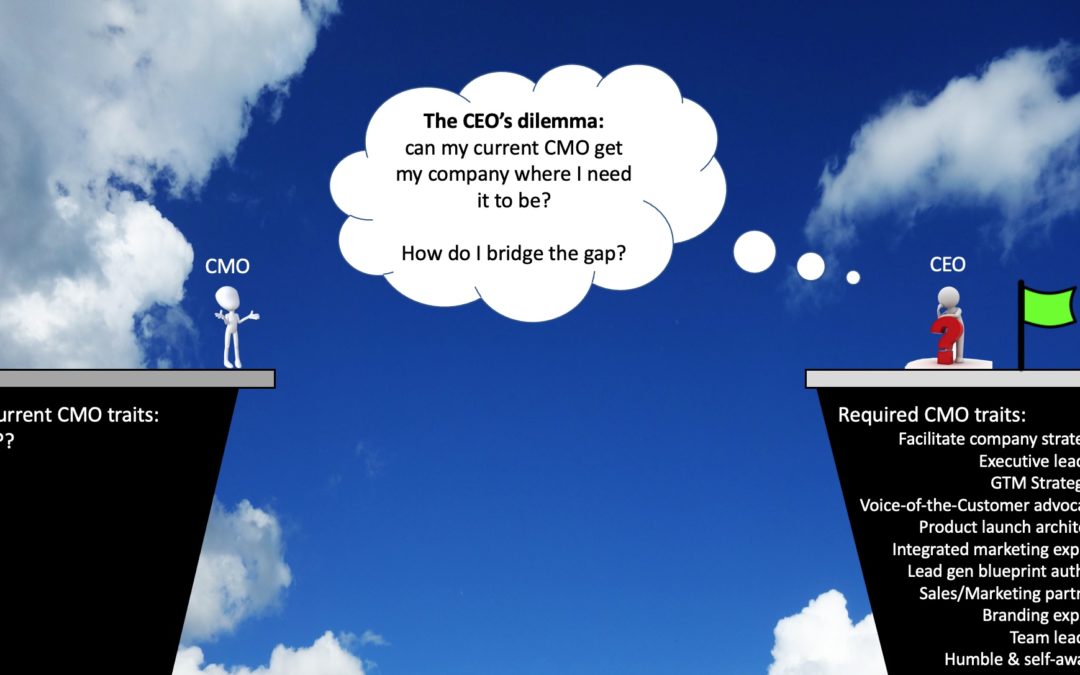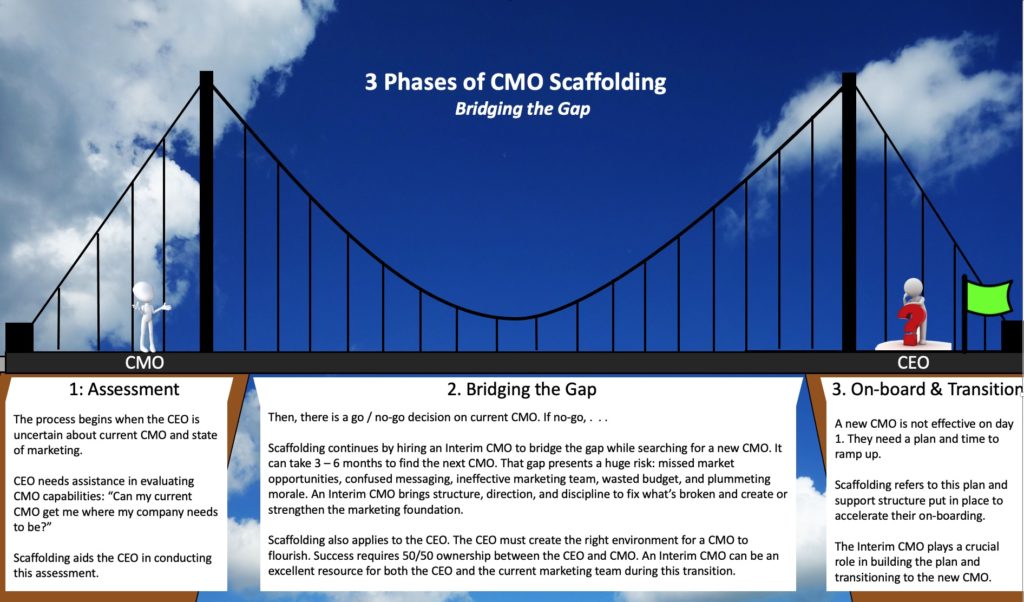I sat down with Brian Gentile, an extraordinary former CMO and CEO, and now Managing Director and CEO coach at 10X CEO. Recently, he’s been coaching CEOs on what a high-functioning CMO looks like and how to nurture a win-win environment for both the CEO and CMO. It’s a concept he calls, “CMO scaffolding”.
Mike: What is CMO Scaffolding?
Brian: The idea came to me from having spent so much time with CEOs talking about, usually in anxiety-filled conversations, the performance of the marketing team, what a high-functioning CMO looks like, if the CMO or VP of Marketing in place today is the right one, when and how to replace this marketing leader if that should be the best path, and then how to get that new head of marketing from their entry point in the company to a point of productivity and real value and strength. After dozens of these conversations, I saw a pattern.
The trigger point for all this is the anxiety a CEO feels when he or she isn’t sure if the current marketing leader is the right one not only for leading today’s company, but for the next phase of the company. Because few CEOs know what a good head of marketing really looks like, they don’t have a good evaluative technique for assessing the current marketing leader.
Simply put, “CMO scaffolding” refers to a support structure that aids both the CEO and the CMO in order to groom the CMO to become the marketing leader the company needs him/her to be.
Mike: What’s the evolution of the CMO?
Brian: The first time you are a CMO, you feel like “I have to be the smartest, most knowledgeable and cleverest marketing person in the room. Every time. That’s my job.” That’s what you think you need to do. It takes maturity and experience to realize that this is not your role. Your role is to marshal every resource you possibly can, facilitate a well-structured marketing strategy and planning process and then curate great ideas, organize the entire team and empower them, all in an effort to drive big outcomes – that’s your job.
Coaching CMOs
A lot of what a CEO might see in a CMO is bravado, pride, and ego. So, CMOs can get in their own way. I often have conversations with CMOs at the request of their CEO. I point out that their CEO is choosing to work with a coach, in a concentrated practice, to become a better CEO. In fact, the CEO’s job is to acknowledge that he/she is never the CEO the company needs; he/she is always becoming the CEO the company needs. This is a massively important distinction of saying, “I’m always working to become the leader I need to be. I’m never there. I need to wake up every day like it is a training day.” CMOs should be thinking about their performance and career in the same way.
My favorite analogy is Serena Williams. Does she wake up and say, “I don’t need a coach today. I’m ready for my next Grand Slam because nobody knows tennis better than me”? No. That’s why she is the world’s best. She wakes up every day knowing, “I have to be better.” Is her coach better on the court than her? No. Can she beat her coach? Of course! Probably left-handed. But, that’s not the point. The coach sees things and can help in ways she cannot. Otherwise, she wouldn’t pay for this person to be her coach. It’s phenomenal to me that in sports, no one questions the need for a coach. But you become a head of marketing, and it is, “no, I’m good; I don’t need a coach.”
Skill building versus networking
Once you become a head of marketing, some portion of your job should be spent outside the company, interacting with other really bright people from whom you can learn. When I was CEO of Jaspersoft I required all my direct reports to spend some time outside the company. The purpose was not to impress anyone. I’d told them to find a group where you can share your challenges, be vulnerable and get some feedback. Be curious about other, better ways to approach your problems and learn from others. This is a great way to maintain your fit at the intersection of product and market and it requires a leader to check his / her ego at the door. If you think your job is different than this, you are mistaken.
With this feedback, Marketing leaders I speak with often respond with an “aha” moment and a bit of defensiveness. They might say they belong to some peer or industry group, which is all fine and good. But, are you really bringing your problems, sharing and getting coaching and wisdom you can actually use to make your Company far more effective? Or are you just going to the peer networking events to impress, have a drink, and just network? It’s almost always more of the latter, little of the former.
Mike: Tell me about the 3 phases of CMO scaffolding
Brian: Like the CEO on their journey, the CMO is always becoming the marketing leader their company needs them to be. There are always skills to be learned. Consider a bridge spanning a gap. The CMO is on one side, but the CEO needs him/her to get to the other. Scaffolding provides strategic and tactical support to get you to the other side.
Let’s take the bridge analogy one step at a time. (Click the picture to enlarge.)
Phase 1: Assessment
It begins when the CEO questions the current success of the head of marketing. Is this person the right marketing leader not only for what my company needs today, but also for what my company needs over the next two or three years? This is a big question, and many CEOs don’t have the experience or understanding of marketing to conduct this evaluation on their own. They need some help. This assessment can be provided by an outside expert (frequently a Coach or Interim CMO). It’s a win for the CEO by showing what a high-functioning CMO looks like. It can also be a win for the current CMO who has potential but is struggling a bit, especially if that person does not have a proper coach. The Interim CMO can provide scaffolding to guide them across the bridge. Whether the current CMO is capable of succeeding, or a new head of marketing is required, scaffolding provides a support structure that reduces the risk of having the wrong leader in place.
Phase 2: Bridging the Gap
Ultimately, this will come to a go/no-go decision on the head of marketing. If the answer is to replace the current CMO, then the second phase of scaffolding applies. Here, CEOs have a choice: hire an Interim CMO to bridge the gap while screening for a new CMO, or leave the leadership position vacant until a new leader is found. Today, finding a new CMO takes between 3-6 months (on average), but it could also take much longer. A vacancy that long puts the company at risk: missed market opportunities, confused messaging, ineffective marketing team, wasted budget, and plummeting morale. Interim CMOs are experts at managing this transition: their skill set is specifically tuned to companies going through a leadership transition. They are also agile thinkers, adept in cleaning house and applying practical and pragmatic marketing best practices. They are non-political “fixers” who will strengthen and reorganize the marketing team so your company presents an attractive opportunity for exactly the type of CMO your business requires.
Phase 3: On-boarding & Transitioning
New CMOs don’t become effective on day 1. High-functioning marketing leaders require time to acclimate, absorb company history, learn about the team, study the current and previous marketing plans, and much more. In fact, unaided, it often takes new CMOs 6 months or longer to reach the point where they are making truly valuable contributions. That’s a long time. Few CEOs recognize this ramp period, leading to frustration.
CEOs need to shrink this time of on-boarding and transition. Effective scaffolding reduces the risk of elongating the CMO ramp-up period. Imagine the Interim CMO running alongside the new CMO and then passing the baton.
Scaffolding the entire span, not just the gap
Success as a CMO is based on both the CEO and CMO; it’s the partnership they foster. Scaffolding is an important concept that helps both leaders. After all, if the CEO fires the prior head of marketing but makes no changes to their own marketing knowledge, attitude, bias, or expectations, then it is quite likely the next CMO will also fail. Failure may be linked to something the CEO is doing regardless of who lands in the CMO chair.
Scaffolding span-to-span via an Interim CMO will help the CEO, CMO, and the entire marketing team. For the CEO, they will gain experience in knowing what a high-functioning marketing leader looks like, and how to structure the marketing organization for accelerated success. For the CMO, scaffolding provides listening and action-oriented coaching to help them become the marketing leader the company needs them to be. For the marketing organization going through a leadership transition, scaffolding provides interim marketing leadership, wisdom, and resources that de-risks and accelerates the path to revenue growth and business success.
For more information:
Whitepaper for CEOs: Hire the best CMO with this proven interview process
Article: 3 Reasons to hire an Interim CMO
About the author
Mike Gospe is a skilled marketing strategist acting as an Interim CMO helping B2B technology companies grow from $50M ARR to $100M ARR. He brings 37 years of marketing expertise and leadership experience across demand gen, product marketing, and brand disciplines. As an Interim CMO, Mike designs and delivers a 90-day plan tailored to address specific marketing needs, cuts “marketing popcorn” (random acts of marketing), and improves efficiencies, all while guiding the executive team to hire the right CMO. Mike is the cofounder of KickStart Alliance, a marketing leadership consulting team.
What makes Mike unique is his lengthy experience as a customer advocate. He coaches marketers to be more empathetic with their customers so they can forge tighter relationships with them. As a Customer Advisory Board (CAB) & Partner Advisory Board (PAB) strategist with more than 20 years of experience and 200+ advisory board meetings under his belt, he’s worked with hundreds of C-suite executives to understand what drives their business, what’s changing, and how B2B companies can provide increased value. His CAB Resource Center, a website sharing a variety CAB strategies and best practices, has become a trusted resource for CAB managers and executive sponsors around the world.
For more information and best practices for working with your CMO and marketing team, please contact Mike Gospe.



Trackbacks/Pingbacks